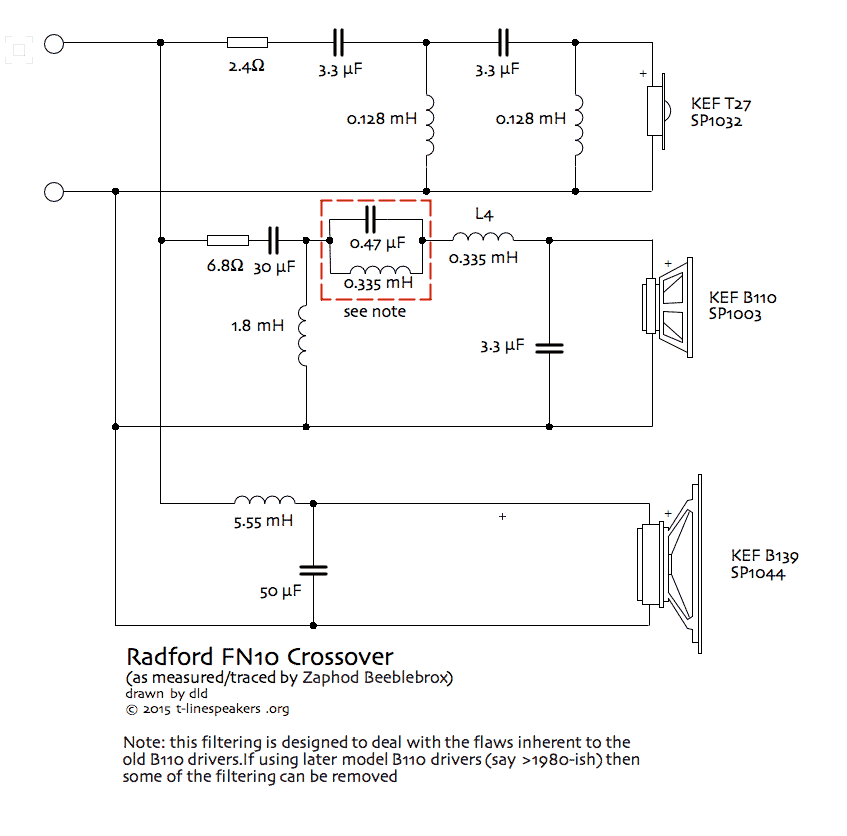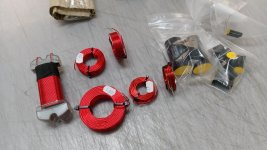Hi all,
Need advise on what type of inductors to use? I was thinking all air-core type except the 1.8 & the 5.55mH to use laminated core inductors from Erse Audio?
Need advise on what type of inductors to use? I was thinking all air-core type except the 1.8 & the 5.55mH to use laminated core inductors from Erse Audio?
You will note that the image you have copied & are pointing too is copyrighted. You should link to the original:

Your link has been removed.
dave

Your link has been removed.
dave

Radford would almost have surely used cored inductors, you may have to adjust things if you use air-core inductors.
Best to ask Zaphod Beeblebrox at KEF transmission line project - DIY Audio Projects - StereoNET
dave
Best to ask Zaphod Beeblebrox at KEF transmission line project - DIY Audio Projects - StereoNET
dave
Already have. He said to use all air-core but a 5.55mH inductors is going to be huge and expensive.
They aren’t that bad. We’ve had to use a few that large or larger inb the few passive WAWs (formerly FASTs) that we have done.
It is in the bass where that coil is used that iron core inductors can saturate, so using one would be a trade-off.
dave
It is in the bass where that coil is used that iron core inductors can saturate, so using one would be a trade-off.
dave
Can you tell me where the best place to buy these? What price would a 5.55mH be worth and what size?
OK, it's a little high, and that is your compromise. To be honest, it will work well enough if you have no options.
How is the sensitivity of the drivers? The heat dissipated by inductors is mainly related to their resistance, and less copper handles it less well. Ironically iron cored inductors can (typically for a given price, for example) have a lower resistance but also suffer at higher levels due to the core saturating and the inductance dropping. It's an apples to oranges comparison. If the air cores can manage your power levels they will be fine once you maybe adjust for the slight effect of the resistance on the driver levels, possibly by increasing resistance to the others.
How is the sensitivity of the drivers? The heat dissipated by inductors is mainly related to their resistance, and less copper handles it less well. Ironically iron cored inductors can (typically for a given price, for example) have a lower resistance but also suffer at higher levels due to the core saturating and the inductance dropping. It's an apples to oranges comparison. If the air cores can manage your power levels they will be fine once you maybe adjust for the slight effect of the resistance on the driver levels, possibly by increasing resistance to the others.
Last edited:
We are talking about old KEF drivers here so not exactly high power.
I have a pair of KEF Concerto's that have the same drivers T27 B110 & B139
The original power rating was 30 watts (altough I have them on a 150 watt per channel amp!)
I checked the crossovers and found some of the electrolytics were completely out of spec. Caps were replaced where necessary and most of the small values changed to plastic caps.
As regards the large bass inductor I found that a replacement high power ferrite core inductor from Falcon Accoustics was a worthwhile upgrade and gave a far better bass definition than the standard KEF crossover inductor.
Audio Inductors 4.01mH - 6.00mH, ferrite, air core, iron dust.
I have a pair of KEF Concerto's that have the same drivers T27 B110 & B139
The original power rating was 30 watts (altough I have them on a 150 watt per channel amp!)
I checked the crossovers and found some of the electrolytics were completely out of spec. Caps were replaced where necessary and most of the small values changed to plastic caps.
As regards the large bass inductor I found that a replacement high power ferrite core inductor from Falcon Accoustics was a worthwhile upgrade and gave a far better bass definition than the standard KEF crossover inductor.
Audio Inductors 4.01mH - 6.00mH, ferrite, air core, iron dust.
The original DN12 crossover used in the Concerto's was the weak link. This Radford updated FN12 with all aircore inductors will make them shine.We are talking about old KEF drivers here so not exactly high power.
I have a pair of KEF Concerto's that have the same drivers T27 B110 & B139
The original power rating was 30 watts (altough I have them on a 150 watt per channel amp!)
I checked the crossovers and found some of the electrolytics were completely out of spec. Caps were replaced where necessary and most of the small values changed to plastic caps.
As regards the large bass inductor I found that a replacement high power ferrite core inductor from Falcon Accoustics was a worthwhile upgrade and gave a far better bass definition than the standard KEF crossover inductor.
Audio Inductors 4.01mH - 6.00mH, ferrite, air core, iron dust.
I will be hand making these Radford xovers for my dads Bailey's.
Have a look here for some ideas: SEAS-3-Way-Classic
The only important thing is to have the coils not near each other, as this will change the inductance.
Ralf
The only important thing is to have the coils not near each other, as this will change the inductance.
Ralf
I'll take a shot at it. I see Erse has got all the inductor measures online, for Dayton I'm not sure I see any. Would you measure Length and diameter for I would draw these as 2 dimensional objects on a board in a pcb making software so you can solder all the conections on the bottom side of it and the upper side would be clear from it, with -IN+ ; -W+; -M+ ; and -Tw+ only. I think I'll need a day or two for it.
I worked it out today. Will put drawing of what it may look like. I'm using a termination strip that runs through the center.
Last edited:
- Status
- Not open for further replies.
- Home
- Loudspeakers
- Multi-Way
- Need Advise - Radford Crossover Inductors



